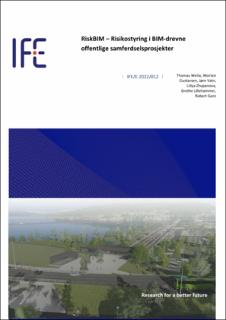| dc.description.abstract | This report summarizes the main results from the RiskBIM project (Risk management for BIM-driven public transport projects) supported by the Norwegian Research Council. RiskBIM dealt with the use of digital models and BIM tools in risk management for transport projects. The overall goal of the project was to improve current work processes, methods, and tools for risk management by exploiting the potential of BIM (Building Information Model), with a special focus on RAMS (Reliability, Availability, Maintainability and Safety) and SHA (Safety, Health, Working Environment). New knowledge in the project was mainly obtained by developing various new innovative concepts within the topic and testing or piloting these in a realistic setting (pilot studies). The RiskBIM-project developed various concepts that can help to utilize BIM for the risk subjects in a better way:
• Visualize risk-related information in the BIM model and update this information in BIM
• Interaction between design and RAMS in BIM by utilizing a project collaboration tool and linking this to BIM
• Integrate and visualize risk from different subjects in maps and models throughout the life cycle of a project
• Use the open BIM standard BCF for the exchange of risk-related information
• Streamline and automate risk analyses by turning risk models into BIM The concepts were implemented in or connected to BIM (and GIS) through prototype solutions developed in RiskBIM. The solutions were subsequently tested by various project participants through pilot studies with user involvement where it was demonstrated improvements by means of:
• Improved visualization of risk factors
• User-friendly web-based concept that connects BIM with risks and hazards
• Linking risk-related information to BIM, or linking information in BIM to risk models
• Use open and free standards
RiskBIM had its main focus on the design and construction phase of transport projects, but student work also shed light on the use of BIM in the operation and maintenance phase to explore the opportunities BIM can provide after transport projects have been completed. The studies showed that there are a number of challenges related to BIM in the operations and maintenance phase that either need to be solved in order to use BIM for certain purposes, or require clarification of which alternative tools to use instead of BIM (e.g. GIS, maintenance management systems, etc.). | en_US |
